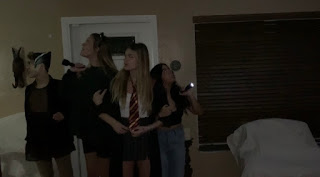Hello! To help my group and I get a better understanding of how the opening titles of our final project should be, we watched a couple of examples of title sequences from different horror movies and then answered some questions for each film. One of the title sequences that we researched was of the 2000 film Ginger Snaps. Directed by John Fawcett, Ginger Snaps tells the story of two death-obsessed sisters, outcasts in their suburban neighborhood, must deal with the tragic consequences when one of them is bitten by a deadly werewolf.
How many titles were displayed during the opening sequences to the film?
For the main opening title sequence of the film, 21 slides were shown that displayed the cast, the writers, who the music and make-up were by, the producer, the director, etc... but in the early beginning of the film 3 titles were shown that displayed the movie company credits and the name of the movie.
What images are prioritized in the opening sequence?
The images that are prioritized are a slideshow of gruesome, macabre, deaths. The reason these images are prioritized is so that the audience can get an idea of the personalities and character traits of the two main leads. Another reason is to set the un-nerving tone for the rest of the movie.
What connotation do these images carry?
The images displayed carry a heavily negative and dark connotation. The images of violent, gory deaths create an unsettling feeling of melancholy and dread. The images help to show that the movie will not be a happy one and that the main characters in the film will not be the usual nice or friendly girl that are frequently shown in other horror movies.
How is genre reinforced through symbolic and technical codes from the outset?
Genre is reinforced through the technical codes by using the hand-held shaky cam. Using this type of shot gives the opening a raw and real feeling. The way the camera pans over the images of dead bodies helps establish the un-nerving feeling that horror movie are supposed to give. In-between titles, clips of the main characters were shown laughing and being happy, this action of the characters show the audience that these girls are not totally evil or psychotic.
How does the film establish an enigma from the outset?
This film is able to establish an enigma by not giving the main characters any personality traits other than the fact that they have in interest in the macabre. The opening also does not give a shred of any information on the plot of the film, and it allows the audience to wonder “what is wrong with these two girls” or “what is going to happen to these girls”.
What strategies are used to ensure the film appeals to its target audience?
The strategies used to ensure the film appears to the target audience are the overwhelming amount of blood and gore. A huge element of horror movies is the use of gory imagery. This movie opens with horrific violent images such as a girl with a pitchfork in her throat to another girl was run over by a lawnmower. The use of this element will appeal to gore-lovers and persuade them to want to keep watching the film.
How has technology been used effectively? You want to consider camera angles, transitions, and editing techniques?
The technical use in the film is very clever. The camera jumps and flashes between an image at multiple different angles eventually landing on one of the images for a prolonged time to display the title. The way the shot of the images jump and flash before each other makes it look as if a photo camera were taking those pictures with the flash on. This transitioning technique becomes impressive after the titles are done and it is revealed that the images shown in the opening are part of a slideshow presentation. There is also a very diverse use of camera angles. The film uses a lot of oblique angles and high angles to make the opening a little more cryptic and it also separates the audience from the film.
All in all, Ginger Snaps was a film with a great opening title sequence. The opening used many of the horror movie elements and will definitely leave an impact on the audience.




















